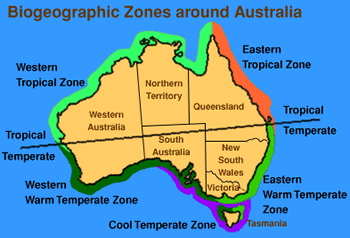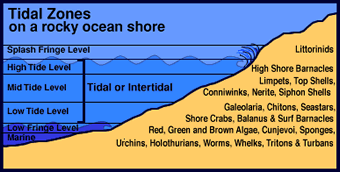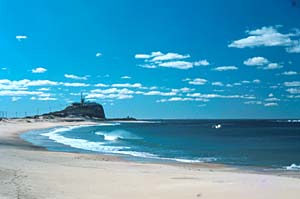|
|
Intertidal Zonation

If you visit an ocean shore in each of the five Biogeographic Zones around Australia, not only has each organism and algae a preferred distribution range, but each type of organism also has a perferred habitat range up and down each shore, with its upper and lower limit determined by different environmental and biological factors. This often creates a shore pattern of distinct parallel bands of species across a shore level with the water surface. This pattern has been called intertidal zonation.
Although Intertidal Zonation as a concept is usually only applied to rocky shore animals and algae, it also occurs on sandy and muddy shores .
Rocky Shore Zonation:

On rocky shores, the horizontal banding of creatures is generally obvious and has been called by marine researchers intertidal zonation. The researchers have used the varying lunar-month tide levels and/or indicator species to define these levels.
Some of the researcher's terminology is complex and uses descriptions like infralittoral, high midlittoral, high-water spring and high-water neap tides, upper and lower barnacle zone and cunjevoi zone.
In this web site I will use a generalised scheme based on assumed tide levels for any Australian shore.
The
levels I will discuss for the
Eastern Warm Temperate Biogeographic Zone are:
- Splash Fringe Level
- High-tide Level
- Mid-tide Level
- Low-tide Level
- Low Fringe Level, and
- Marine or Sub-tidal Level
Vertical Distribution Pattern for Animals and Algae in the Eastern Warm Temperate Zone of Australia

Sandy Shore Zonation:

In southern Australia, on high-energy sandy beaches, the sand is coarse and generally slopes away into the water. This is a constantly shifting environment, with sand grains buoyed up in the water when the tide is high. Animals have to be very specialised to live here. These beaches have the lowest number of animals.
Protected beaches have fine sand, which if supported by water, is easy to bury down into, and always remains moist. Here a very large range of microscopic animals move among the sand particles in suspension. In Australia we know very little about these minute animals.
Larger animals that live on sandy beaches are the surf crabs, Pipi, Donax deltoides, cockles and moon shells, several species of beachworm, as well as numerous isopods and amphipods (sand-hoppers) scrambling around under torn-off kelp fronds. No large algae can survive here, only microscopic algae.
Higher up on the sand shore are the the eeastern and western ocypode (ghost) crabs, the related northern Sand Bubbler Crab, Scopimera inflata, and the southern Burrowing Shore Crab, Leptograpsus octodentatus.
Estuarine Shore Zonation:
There is a wide range of habitats in an estuary, a number often occurring across a short distance. Close to the estuary or river mouth, the shore is usually sand. Because wave energy is not as strong as found on the open coasdt, the sand is usually packed down, so is unsitable for intertidal animals, algae or seagrasses.
Moving away from the estuary entrance, wave energy decreases and the percentage of mud in the substrate increases. Here extensive seagrass beds occur. Many intertidal and estuarine-preffering animals live in the seagrass flats.
Further into the embayment, muddy shores become more common, fringed by mangrove forest and backed by extensive salt-marsh flats. These are only covered by the highest tides.
Where a river enters the estuary, the water becomes brackish, so oysters, mud whelks and polychaete worms become common.
All of these habitats have their own specialised creatures and plant forms which, when occurring on a shore, often lie in parallel bands. The more gentle the slope, the broader the habitat band. But here on an estaurine shore, many of the species are not attached to the substrate, so it is more like a zonation of habitats and their associated organisms.
References
Bennett, I. (1987) W. J. Dakin's classic study: Australian Seashores. p. 3-12, Angus & Robertson, Sydney.
Davey, K. (1998) A Photographic Guide to Seashore Life of Australia. p.8, New Holland, Sydney.
Eastern
Warm Temperate Zone
Western Warm Temperate Zone
Cool Temperate Zone
Eastern Tropical Zone
Western Tropical Zone
Home
Page
Taxonomy
Biogeography
Rocky Shores
Tidal Levels
Intertidal Zonation
Environmental Factors
Biological
Factors
Feeding Relationships
Activities
Glossary
References
 Life
on Australian Seashores
Life
on Australian Seashores
by Keith Davey (C) 2000
Learning Consultant
- Media
The University of Newcastle
email at australian_seashores@hotmail.com
Scientific Consultant: Phil
Colman
site created 01.01.98 : updated 01.04.2000
